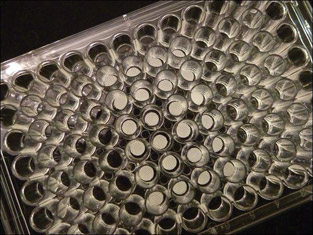
NIST Reference Scaffolds for Cell Culture Growth
There has long been a need in the tissue engineering/regenerative medicine sector for reference scaffolds to serve as physical standards for the materials that are used as beds for the growth of cell cultures. The National Institute of Standards and Technology has created such references, which will eventually be accompanied by an ASTM International standard currently under development that will provide instruction for use of the NIST scaffolds in cell culture testing.
The proposed ASTM standard, WK39698, Test Method: Using NIST Tissue Engineering Reference Scaffolds for Cell Culture Tests, is being developed by Subcommittee F04.42 on Biomaterials and Biomolecules for TEMPs, part of ASTM International Committee F04 on Medical and Surgical Materials and Devices.
Once approved, the proposed standard will be used hand in hand with the RM8394 NIST Reference Material scaffolds for cell culture (to be released in April 2013) as a stable, reproducible three-dimensional scaffold substrate for controls in scaffold development.
The proposed standard will provide users - including tissue engineers, those using 3-D for drug screening and those developing 3-D in vitro disease models - with a very specific protocol for measuring cell adhesion and proliferation in a 3-D scaffold, using the NIST reference scaffolds as controls.
"Culture in 3-D scaffolds is much harder than on traditional flat culture dishes," says Carl G. Simon Jr., Ph.D., a NIST biologist and F04 member. "Seeding cells onto 3-D scaffolds is more difficult due to their porous nature and because they are not attached to well bottoms."
Simon notes other difficulties that make it challenging to get consistent results when testing 3-D scaffolds:
- Proliferation can be uneven due to uneven seeding and 3-D transport of nutrients and waste.
- Getting cells out of scaffolds due to pores can be hard, making it difficult to measure cell state.
- Imaging cells is more difficult since scaffolds are opaque and the surfaces are uneven.
For all of these reasons, the NIST scaffolds and the accompanying ASTM standard will serve as benchmarks for comparison to unknowns and enable interlaboratory comparisons.
Simon notes that all parties with an interest in 3-D cell culture are invited to join in the development of WK39698.
CONTACT Technical Information: Carl G. Simon Jr., Ph.D., National Institute of Standards and Technology • Gaithersburg, Md. • Phone: 301-975-8574 | ASTM Staff: Pat Picariello • Phone: 610-832-9720 | Upcoming Meeting: May 21-24 • May Committee Week • Indianapolis, Ind.
 SN Home
SN Home Archive
Archive Advertisers
Advertisers Masthead
Masthead RateCard
RateCard Subscribe
Subscribe Email Editor
Email Editor